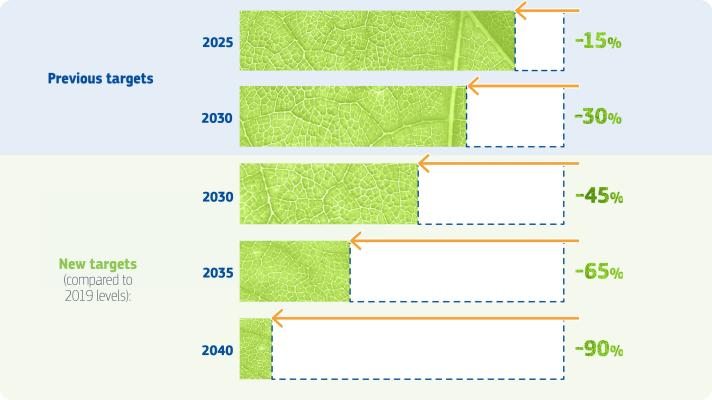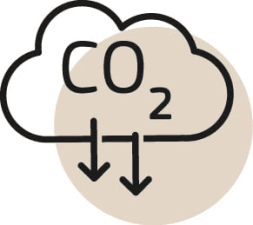Lorries, buses and coaches are responsible for more than a quarter of GHG emissions from road transport in the EU, and for over 6% of total EU GHG emissions. Despite some improvements in fuel consumption efficiency in recent years, these emissions are still rising, mainly due to increasing road freight traffic.
To fight the climate crisis, we need to bring down CO2 emissions in this field. To do so, the Commission is proposing new targets which will raise our ambition and meet the EU’s climate and zero pollution objectives while lowering demand for fossil fuels.
Raising our ambition
In 2023, the Commission proposed a revision of the Regulation on CO2 emission standards for heavy-duty vehicles. If adopted, the proposal would introduce new, stronger CO2 emission standards for heavy-duty vehicles from 2030 onwards, and extend the scope of the Regulation to cover smaller trucks, city buses, long-distance buses and trailers.

To stimulate faster deployment of zero-emission buses in cities, the Commission also proposes to make all new city buses zero-emission as of 2030.
The new targets build on those adopted in 2019, which were the first-ever EU-wide CO2 emission standards for heavy-duty vehicles.
To enter into force, the Commission’s proposal now needs to be adopted by the European Parliament and the Council of the EU.
Main benefits
If adopted, our proposal will:
|
|
Decrease CO2 emissions per km from new HDV by 90% by 2040, as compared to the reference period (1 July 2019 – 30 June 2020), with intermediate targets for 2030 (45%) and 2035 (65%) |
|
|
Help reach the EU's 2050 climate neutrality target and boost zero-emission mobility |
|
|
Improve air quality and health of Europeans by cutting the level of air pollutants, especially in towns and cities |
|
|
Reduce the fuel expenditure and total cost of ownership for transport operators and all users |
|
|
Lower the EU’s energy dependency on imported fossil fuels, and enhance energy savings and efficiency in the transport sector |
|
|
Provide a clear signal to industry to pursue a zero-emission pathway by investing in innovative zero-emission technologies |
|
|
Increase the share of zero and low-emission vehicles in the market and accelerate the roll-out of recharging and refuelling infrastructure |
|
|
Strengthen the technological and innovation leadership of industry in the EU and create new jobs |
Regulation on CO₂ emission standards for heavy-duty vehicles
Until the revision is adopted, the Regulation on CO2 emission standards for heavy-duty vehicles applies. This Regulation entered into force on 14 August 2019.
As per the Regulation, from 2025 onwards, manufacturers will have to meet the targets set for the fleet-wide average CO2 emissions of their new lorries registered in a given calendar year. Stricter targets will start applying from 2030 on.
The targets are expressed as a percentage reduction of emissions compared to the EU average in the reference period (1 July 2019–30 June 2020):
- From 2025 onwards: 15% reduction
- From 2030 onwards: 30% reduction
The 2025 target can be achieved using technologies that are already available on the market. The 2030 target has been assessed as part of the review of the Regulation.
As a first step, the CO2 emission standards cover large lorries, which account for over 73% of all CO2 emissions from heavy-duty vehicles.
Incentive mechanism for zero- and low-emission vehicles (ZLEV)
The Regulation includes an incentive mechanism for
- Zero-emission vehicles (ZEV), lorries without an internal combustion engine, or with an internal combustion engine that emits less than 1gCO2 per kWhor per km;
- Low-emission vehicles (LEV), lorries with a technically permissible maximum laden mass of more than 16t, with CO2 emissions of less than half of the average CO2 emissions of all vehicles in its group registered in the 2019 reporting period.
To incentivise the uptake of ZLEV and reward early action, a super-credits system applies from 2019 until 2024, and can be used to comply with the target in 2025. A multiplier of 2 applies for ZEV, and a multiplier between 1 and 2 applies for LEV, depending on their CO2 emissions. An overall cap of 3% is set to preserve the environmental integrity of the system.
From 2025 onwards, the super-credits system is replaced by a benchmark-based crediting system, with a benchmark set at 2%. The 2030 benchmark level will have to be set in the context of the 2022 review.
As a result, the average specific CO2 emissions of a manufacturer are adjusted downwards if the share of ZLEV in its entire new heavy-duty vehicles fleet exceeds the 2% benchmark, out of which at least 0.75 percentage points have to be vehicles subject to the CO2 targets, i.e. the largest vehicles. Each percentage point of exceedance of the benchmark will decrease the manufacturer’s average specific CO2 emissions by one percent.
In both systems, ZEV not subject to the CO2 targets are accounted in the incentive mechanism. Buses and coaches are excluded from the scheme. The ZEV not subject to the CO2 targets can contribute to a maximum of 1.5% CO2 emissions reduction.
Cost-effective achievement of targets
The Regulation includes several elements to support cost-effective implementation:
- Banking and borrowing to take account of long production cycles, including a reward for early action, while maintaining the environmental integrity of the targets.
- Full flexibility for manufacturers to balance emissions between the different groups of vehicles within their portfolio.
- Vocational vehicles , such as garbage trucks and construction vehicles, are exempted due to their limited potential for cost-efficient CO2 reduction.
Governance
The following measures will ensure the effectiveness and enforcement of the targets. They are based on the experience from cars and vans :
- Assess the robustness and representativeness of the reference CO2 emissions as a basis for calculating the EU fleet-wide emissions targets.
- Collect, publish and monitor real-world fuel consumption data reported by manufacturers, based on mandatory standardised fuel consumption meters
- Introduce in-service conformity tests and mandate the reporting of deviations and the introduction of a correction mechanism
- Apply financial penalties in case of non-compliance with the CO2 targets. The level of the penalties is set to 4,250 euro per gCO2/tkm in 2025 and 6,800 euro per gCO2/tkm in 2030.
Monitoring and reporting of CO₂ emissions from heavy-duty vehicles
The following measures enable the implementation of the emission standards:
- Certification Regulation on the determination of the CO2 emissions and fuel consumption of new lorries
- Regulation (EU) 2018/956 on monitoring and reporting
The monitoring and reporting Regulation mandates the following monitoring and reporting requirements (with data from 1 January 2019 onwards): :
- Member States monitor and report to the Commission information on the heavy-duty vehicles registered for the first time in the Union;
- Lorry manufacturers monitor and report to the Commission CO2 emission and fuel consumption data as determined pursuant to the certification Regulation for each new vehicle produced for the EU market. This information will be calculated using the Vehicle Energy Consumption Calculation Tool (VECTO).
The collected data on CO2 emissions and fuel consumption, together with other relevant technical information on the vehicles, including the aerodynamic drag, is made publicly available by the European Environment Agency on behalf of the Commission
The new system complements the existing EU reporting system for cars and vans.
Vehicle Energy Consumption Calculation Tool (VECTO)
VECTO is a simulation software that can be used cost-efficiently and reliably to measure the CO2 emissions and fuel consumption of heavy-duty vehicles for specific loads, fuels and mission profiles (e.g. long haul, regional delivery, urban delivery, etc.), based on input data from relevant vehicle components.
The tool has been developed by the Commission in close cooperation with stakeholders.
- CO2 emission standards for heavy-duty vehicles – a slideshow
- 25/07/2019 - Regulation (EU) 2019/1242 - setting CO2 emission performance standards for new heavy-duty vehicles
- 03/07/2018 - COM/2018/284 - Proposal for a regulation setting CO2 emission performance standards for new heavy-duty vehicles (main text + annexes)
- 17/05/2018 - SWD/2018/185 - Impact assessment (main text + annexes)
- SWD/2018/186 - Executive summary of the impact assessment
- 17/05/2018 - Q&A on proposal for CO2 emission standards for heavy duty vehicles
- 17/05/2018 - Europe on the Move III: Europe on the Move: Commission completes its agenda for safe, clean and connected mobility
- 17/05/2018 - Europe on the Move III: Questions & Answers on the Commission's initiatives
- 17/05/2018 - Factsheet: Shaping the future of Mobility
- 17/05/2018 - Factsheet: Clean Mobility – Implementing the Paris Agreement
- 17/05/2018 - All documents on Europe on the Move III
- 05/08/2022 - Regulation 2022/1362 – Energy efficiency determination of heavy-duty trailers
- 28/06/2018 - Regulation 2018/956 - Monitoring and reporting of CO2 emissions from and fuel consumption of new heavy-duty vehicles
- 12/12/2017 - Regulation 2017/2400 - Determination of the CO2 emissions and fuel consumption of heavy-duty vehicles
- 31/05/2017 - COM/2017/0279 - Proposal on the monitoring and reporting of CO2 emissions from and fuel consumption of new heavy-duty vehicles
- 13/03/2019 - Commission Delegated Regulation (EU) 2018/956 - amending Annex I to Regulation (EU) 2018/956 as regards the data on new heavy-duty vehicles to be monitored and reported by Member States and by manufacturers
- Guidance documents and reporting formats
- 21/05/2014 - COM (2014) 285 - Communication: Strategy for reducing Heavy-Duty Vehicles' fuel consumption and CO2 emissions
- 21/05/2014 - SWD (2014) 160 - Impact Assessment accompanying the document Strategy for Reducing Heavy-Duty Vehicles Fuel Consumption and CO2 Emissions
- SWD (2014) 159 - Executive summary
- 21/05/2014 - IP/2014/576 - Climate action: Commission sets out strategy to curb CO2 emissions from trucks, buses and coaches
- 21/05/2014 - MEMO/2014/366 - Questions and Answers on the Commission strategy for reducing Heavy-Duty Vehicles' (HDVs) fuel consumption and CO2 emissions
- 26/07/2023 - Final report - Support for aerodynamic modelling of heavy-duty trailers
- 26/07/2023 - Validation report of the computational fluid dynamics simulation method according to Annex V of Regulation (EU) 2022/1362
- 27/09/2022 - Final report: Bodies and trailers - Support Preparation of Legislation on Trailers Certification
- 29/11/2019 - Final report: Further Development of VECTO
- 21/11/2019 - Final report: Bodies and trailers – development of CO2 emissions determination procedure
- 10/2019 - Preparation for collection and monitoring of real-world fuel consumption data for light-duty and heavy-duty vehicles
- 09/2018 - Support for preparation of the impact assessment for CO2 emissions standards for Heavy Duty Vehicles
- 08/2017 - Analysis of fuel economy and GHG emission reduction measures from Heavy Duty Vehicles in other countries and of options for the EU
- 12/2017 - LOT 4 report: "VECTO tool development: Completion of methodology to simulate Heavy Duty Vehicles' fuel consumption and CO2 emissions. Upgrades to the existing version of VECTO and completion of certification methodology to be incorporated into a Commission legislative proposal"
- 12/2017 - Final report: "Feasibility assessment regarding the development of VECTO for hybrid heavy-duty vehicles"
- 03/2016 - Monitoring heavy-duty vehicles’ CO2 emissions and their costs: An assessment
- 27/03/2015 - Light weighting as a means of improving Heavy Duty Vehicles’ energy efficiency and overall CO2 emissions
- 26/01/2015 - Final report: Cost-benefit analysis of options for certification, validation, monitoring and reporting of heavy-duty vehicle fuel consumption and CO2 emissions
- 08/01/2015 - Data gathering and analysis to improve understanding of the fleet, market and CO2 emissions of N2 and M2 category of vehicles
- 08/09/2014 - Cost-benefit analysis of options for certification, validation, monitoring and reporting of heavy-duty vehicle fuel consumption and CO2 emissions (Interim report)
- 15/05/2014 - Development and validation of a methodology for monitoring and certification of greenhouse gas emissions from heavy duty vehicles through vehicle simulation
- 03/02/2014 - Development of a CO2 certification and monitoring methodology for HDV - Proof of concept report
- 29/07/2013 - Tyre Pressure Monitoring Systems (TPMS) as a means to reduce Light- Commercial and Heavy-Duty Vehicles fuel consumption and CO2 emissions
- 18/09/2012 - Final report on HDV CO2 emission abatement cost curves
- 09/01/2012 - Reduction and Testing of Greenhouse Gas Emissions from Heavy-Duty Vehicles - Lot 2: Development and testing of a certification procedure for CO2 emissions and fuel consumption of HDV
- 23/12/2011 - European Union Greenhouse Gas Reduction Potential for Heavy-Duty Vehicles
- 22/02/2011 - Reduction and Testing of Greenhouse Gas Emissions from Heavy-Duty Vehicles – Lot 1: Strategy
- 03/2008 - Reducing Greenhouse Gas Emissions from Heavy-Duty Vehicles








